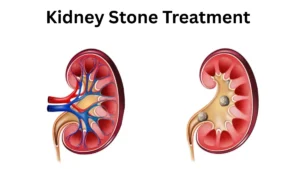Kidney Stone Treatment
Kidney stones are a common and painful urological condition affecting millions worldwide. Fortunately, today’s medical advancements offer a wide range of treatment options tailored to each individual’s condition. Whether you’re dealing with a small stone or a complex case, understanding your options can help you find effective and lasting relief.
In this article, we’ll walk you through kidney stone treatment, from symptoms and diagnosis to cutting-edge procedures and long-term prevention strategies.
What Are Kidney Stones?
Kidney stones are hard mineral and salt deposits that form inside the kidneys. They can range in size from a grain of sand to a golf ball and may remain in the kidney or move into the urinary tract, causing intense pain and discomfort.
Types of Kidney Stones
- Calcium Oxalate – Most common; linked to high oxalate intake
- Uric Acid – Often associated with high-protein diets
- Struvite – Linked to urinary tract infections
- Cystine – Rare, hereditary stones due to a genetic disorder
Common Symptoms
- Severe pain in the back, side, or lower abdomen
- Nausea and vomiting
- Painful urination
- Blood in urine (hematuria)
- Frequent urge to urinate
Read more: Epidural Injection Price in UAE: What Expecting Mothers Should Know in 2025
How Are Kidney Stones Diagnosed?
Accurate diagnosis is essential for choosing the right treatment. Here’s how healthcare providers typically diagnose kidney stones:
| Test | Purpose |
|---|---|
| Physical Exam | Checks for signs of tenderness or referred pain |
| Urine Test (24-hour test) | Identifies risk factors and helps detect infections |
| Blood Test | Measures calcium, uric acid, and kidney function |
| Imaging (Ultrasound, CT) | Locates stones and determines size, location, and obstruction |
| Stone Analysis | Reveals stone composition for personalized prevention |
Treatment Options for Kidney Stones
The best treatment depends on the stone’s size, type, and location, as well as your symptoms and overall health. Here are the most common treatment methods:
Conservative Management (For Small Stones)
- Hydration: Drinking 2–3 liters of water daily can flush out small stones naturally
- Pain Management: Over-the-counter NSAIDs or prescription painkillers may be used
- Alpha-Blockers: Medications like tamsulosin help relax the ureter and ease stone passage
Extracorporeal Shock Wave Lithotripsy (ESWL)
- Non-invasive procedure
- Uses high-energy shock waves to break stones into passable fragments
- Ideal for stones smaller than 2 cm
- Minimal recovery time
Ureteroscopy (URS)
- Minimally invasive
- A thin scope is passed through the urethra and bladder into the ureter
- Stones are broken up using a laser or removed
- No incisions required
Percutaneous Nephrolithotomy (PCNL)
- Used for large or complex stones
- A small incision is made in the back to access the kidney
- A nephroscope removes or breaks the stone
- Requires anesthesia and short hospital stay
Read more: Hair Transplant Abu Dhabi: Restore Your Confidence with Natural-Looking Results
Retrograde Intrarenal Surgery (RIRS)
- A flexible ureteroscope is inserted through the urinary tract
- Uses laser to break up kidney stones
- Ideal for upper ureter or intrarenal stones
Open or Laparoscopic Surgery (Rare)
- Reserved for very large stones or structural abnormalities
- Involves longer recovery time but high success rate
Read more: Home Insurance Dubai: Your Ultimate Guide to Protecting Your Home in 2025
India and Dubai (2025 estimates)
| Treatment Type | India (INR) | |
|---|---|---|
| ESWL (Shock Wave Lithotripsy) | ₹30,000 – ₹60,000 | AED 5,000 – AED 10,000 |
| URS (Ureteroscopy) | ₹40,000 – ₹80,000 | AED 7,000 – AED 15,000 |
| PCNL (Percutaneous Nephrolithotomy) | ₹70,000 – ₹1,50,000 | AED 10,000 – AED 20,000 |
| RIRS (Laser Surgery) | ₹80,000 – ₹1,60,000 | AED 12,000 – AED 22,000 |
| Open Surgery | ₹1,00,000 – ₹2,00,000 | AED 15,000 – AED 25,000 |
Preventing Kidney Stones
Once you’ve had a kidney stone, you’re more likely to develop another. Here’s how to prevent recurrence:
Hydration
- Drink enough water to produce at least 2–2.5 liters of urine per day
Diet Changes
- Limit sodium and oxalates (spinach, beets, nuts)
- Reduce animal proteins (especially red meat)
- Eat more citrate-rich foods (lemons, oranges)
Medication
- Diuretics or citrate supplements may be prescribed based on stone type
- Follow your doctor’s advice on calcium intake and vitamin D use
Regular Monitoring
- Follow-up tests to track kidney function and prevent future stones
- Stone analysis for personalized recommendations
When Should You See a Doctor?
Seek medical attention if you experience:
- Persistent or severe pain
- Blood in urine
- Difficulty urinating
- Signs of infection (fever, chills)
- Recurrent stones
Frequently Asked Questions (FAQs)
Can kidney stones go away on their own?
Yes, small stones (under 5mm) can often pass naturally with hydration and pain management.
How long does it take to pass a kidney stone?
It can take anywhere from a few days to several weeks, depending on the size and location of the stone.
Is surgery always required?
No. Many stones are treated non-surgically. Surgery is only considered for large, stubborn, or symptomatic stones.
What are the best drinks for kidney stones?
Water, lemon juice (citrate), and coconut water are helpful. Avoid sugary sodas and high-oxalate drinks like tea.
Can diet alone prevent kidney stones?
Diet plays a big role, but genetics and other health conditions also influence stone formation.
Final Thoughts
Kidney stone treatment has evolved significantly, with highly effective options ranging from conservative care to advanced minimally invasive surgeries. The key lies in timely diagnosis, proper treatment planning, and preventive strategies to avoid recurrence.
If you’re experiencing symptoms or have a history of kidney stones, consult a certified urologist or nephrologist for a personalized care plan.





